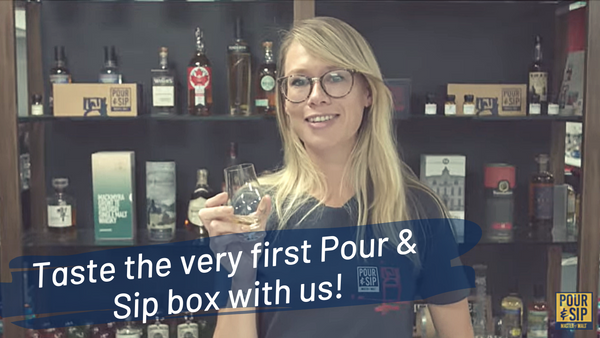How New Zealand's Cardrona Distillery came to be

Nestled in a picturesque rural valley, Cardrona Distillery and its whisky has exceeded all expectation – even that of its founder! We grabbed a moment with master distiller Sarah Elsom to talk all about the distillery’s journey as well as her own.
Trying to arrange a meeting with someone halfway across the world is something of a scheduling nightmare. So when I manage to grab a moment of Cardrona’s master distiller, Sarah Elsom, it’s early morning for her – while I’m easing into my evening with a whisky, she’s beginning her day with her morning coffee.

The first thing Elsom does is “pay a huge amount of credit to the woman who started it all, Desiree Whitaker.” Around six years old now, Cardrona is her brainchild. Whitaker’s story begins when she dropped out of a law degree, and went over to the UK and started pouring pints, “like so many Kiwis do when they’re soul searching around that age!” Elsom remarks. Though she wasn’t a big drinker, this is when she fell in love with Scotch and single malt whiskies.
Whitaker’s first distillery tour cemented her love for whisky, but when she returned to New Zealand she ditched the barley to follow her family business – dairy farming. She ended up owning it and making it hugely successful within around five years: “It wasn’t for her, but she just did it because she was good at it.” She sold the farm, which gave her the money to pursue a passion project which, after a couple of years of figuring out what she wanted to do, ended up being perfumery (for a while, at least).
It was in researching the distillation of alcohol for perfume that she found herself attending more and more whisky events. Eventually whisky took over the perfume dream – although there are still over 2,000 ancient perfumery roses planted on-site at the distillery, “a little part of the dream that’s never dropped off,” says Elsom.

In 2015 the current distillery was built, and spirit was running off the stills by November. To win the neighbourhood over and gain consent for something of that size involved a lot of work. The rural distillery is in a stunning valley, but shouldered by two towns that are growing rapidly thanks to tourism and the likes of skiing, biking, and hiking. Elsom describes the area as “sleepy, but on the move,” and after a whirlwind of a year all was well. The community was totally supportive and even excited.
When the distillery (and the dream) became bigger than the capital from the sale of the farm, Whitaker needed investors to help her grow. Her parents matched her dollar for dollar in the build, and they’re still very much involved, along with two other Kiwi families. The sky’s the limit for her: “We’re thinking about increasing production, while she’s already thinking about building the next distillery,” Elsom explained.
Sarah Elsom, master distiller
Elsom has been at Cardrona pretty much since day one, but whisky wasn’t always on the cards for the New Zealand native. “I studied winemaking and was home in between harvests, and heard that it was being built.” She initially just went over for a chat, her interest piqued, but ended up with a full time job. She joined the team before the distillery was ready to start production, so ended up getting stuck in with the building of it.

As a winemaker, Elsom became attuned to smell, flavour, and mouthfeel. “We’re all oak fiends,” she says of her previous colleagues. “With winemaking I was always travelling, so I never got to see the lifecycle of the wine. I love the hustle and bustle, and speed of production, and working with my hands.” Of switching from a blending role in wine to a production role within whisky, she believes “creating something is just as exciting as pulling something together.” She’ll be able to put her blending skills to use in a few years once the distillery’s stocks come of age.
The flavour of Cardrona
So, in terms of flavour, what makes Cardrona unique? “We definitely celebrate our location, more so with maturation and barrels.” In short, it’s the lengthy fermentation, a decent proportion of first-fill ex-bourbon barrels, and accelerated maturation.
“Our fermentation length is quite long – we wouldn’t draw from our washback until around 70 hours,” says Elsom. “Even then, because we’re only producing 9-5, it can be over another 100 hours until it sees a still, so the ester profile is huge. Lots of fruity banana, pear, and florals.”
While the stills are big in terms of the New Zealand whisky industry, they’re tiny on the world scale (the wash still is only 2,000 litres, and the spirit still is 1,300). This, coupled with a slow distillation, means there’s loads of copper interaction with the spirit, resulting in ample opportunity to remove any sulphites in the spirit and create sweetness. There’s plenty of reflux*, but the spirit is by no means lacking in character.
Cask-wise, it’s all about first-fill ex-bourbon barrels, with a few first-fill ex-sherry casks (Oloroso and Pedro Ximénez) which Elsom notes they’re very lucky to find. “We’ve also made the most out of being in a place that’s renowned for Pinot Noir,” she notes, so expect a smidge of red wine influence there too.
The team has recently started working with New Zealand-grown barley, but when they first started that wasn’t a viable option. They had to bring the malt in to begin with. “That was a quality decision – we weren’t willing to compromise,” Elsom tells me, for the sake of boasting about using local barley. Interestingly, the environmental conditions are perfect, but the farmers just weren’t interested in growing distilling-grade barley. As the whisky industry grew in the country, so did the demand for such barley, so both industries grew up together.

Thanks to the altitude, the temperature fluctuations between day and night, and the seasons, are huge. “We’re seeing maturation characters in our whisky earlier than we had ever hoped for,” Elsom says.. “We need to keep an eye on things – we don’t want it to go too far too early.” Originally, Whitaker didn’t want to launch a whisky until early 2025 with the first release at 10 years old. “It was in recognising that there was a real thirst for New Zealand whisky that we decided to release something of a progress report,” and that was Just Hatched at just three years old.
“Just Hatched blew everyone away, thanks to those mountain influences and extraction of flavour and colour from the wood. But it was quite clunky – whisky is all about finding that sweet spot. What we can see with Growing Wings [at five years old] is that the harmony between spirit and wood is becoming more aligned. It’s not as sweet and in your face as Just Hatched, it’s really coming into its own.” These are both a snapshot in time, and an indication of what’s to come. Cardrona won’t be releasing whiskies of this age ever again. “Knowing that it’s not forever makes it that much more special.”
*Reflux is when spirit vapour comes into contact with a cooler surface inside the still, condenses back into a liquid, falls back down the still and is then re-distilled, resulting in a lighter and more complex spirit.



